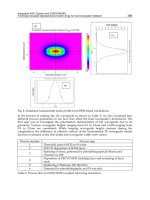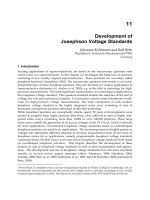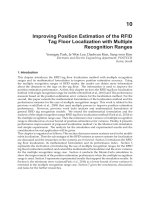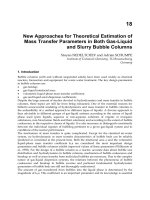Rubber Compounding - Chemistry and Applications Part 11 ppsx
Bạn đang xem bản rút gọn của tài liệu. Xem và tải ngay bản đầy đủ của tài liệu tại đây (1.18 MB, 48 trang )
10
Antioxidants and Other
Protectant Systems
Sung W. Hong
Crompton Corporation, Uniroyal Chemical,
Naugatuck, Connecticut, U.S.A.
I. INTRODUCTION
To extend the service life of vulcanized rubber goods, it is very important to
protect them from oxygen, ozone, light, heat, and flex fatigue. Most natural
and synthetic rubbers containing unsaturated backbones—natural rubber
(NR), styrene butadiene rubber (SBR), polybutadiene rubber (BR), and
nitrile rubber (NBR), for example—must be protected against oxygen and
ozone. Usually, internal components that are not exposed to atmosphere
require only antioxidants. However, external components that are exposed
to the environment require both antiozonants and antioxidants.
Antioxidants react with oxygen to prevent oxidation of vulcanized
rubber and react with free radicals that degrade vulcanized rubber.
There are four principal theories on the mechanisms of antiozonant
protection of vulcanized rubber. The first is the scavenger theory, which
postulates that the antiozonant competes with the rubber for ozone. The
second theory is that the ozonized antiozonant forms a protective film on the
surface of the vulcanized rubber, preventing further attack. The third
mechanism postulated is that the antiozonants react with elastomer ozonide
fragments, relinking them and essentially restoring the polymer chain. The
fourth theorized mechanism suggests that Criege zwitterions are formed from
the ozonide produced.
Paraffinic and microcrystalline waxes are often added to the rubber as
protective agents. Usually, waxes have poor solubility in rubbers, so they
4871-9_Rodgers_Ch10_R2_052404
MD: RODGERS, JOB: 03286, PAGE: 457
Copyright © 2004 by Taylor & Francis
migrate to the surface of the vulcanized rubber and form a protective film or
barrier that prevents ozone attack. During dynamic flexing, these barriers can
be broken, exposing the rubber to ozone attack. Therefore, waxes can protect
against ozone only under static conditions. Antiozonants alone do not
prevent ozone cracking at the initial stage, because their migration rate is
much slower than that of waxes owing to their better solubility. One theory
supporting the combination of antiozonant with wax is that the wax would
accelerate migration of the antiozonant to the surface for protection against
ozone. Therefore most exterior rubber goods contain both antiozonant and
wax for both static and dynamic protection from ozone cracking.
Commercially available antioxidants usually protect vulcanized rubber
at temperature below 120jC. Above this temperature, special polymers or
types of cross-link systems provide better protection. For example, a peroxide
cure system would provide carbon–carbon cross-links whose bonding energy
is the strongest. Also, a monosulfuric cross-link has much higher energy than
a polysulfuric bond. The lower the bonding energy, the more easily cross-links
break, which would deteriorate the vulcanized rubber’s physical properties
after heat aging. Cure systems with a higher level of accelerators and lower
sulfur levels are known as semiefficient cure systems (semi EV cure). Such a
system provides better heat aging properties than the conventional cure
system, which has a smaller amount of accelerator and a higher level of
sulfur. In this chapter, the protection of mechanical rubber goods through
selection of antioxidants, antiozonants, waxes, and the design of the vulcan-
ization system will be discussed.
II. ANTIOXIDANTS
A. Oxidative Degradation
Generally, the greater the amount of unsaturation in the polymer, the more
susceptible it is to degradation. Highly unsaturated polymers can be attacked
by oxygen, especially when energy is applied. The application of energy may
come from heat, shear, and ultraviolet (UV) light, which promote faster
oxidation.
Oxidative degradation of the polymers is a free radical process. This
oxidation process, known as auto-oxidation, consists of three steps: initiation,
propagation, and termination, as depicted in Figure 1.
Free radicals are formed during initiation reactions. Energy from heat,
mechanical shearing, or high energy radiation can dissociate the chemical
bonds in the polymers (RH) resulting in the formation of free radicals (R
Á
)
[reaction (1)]. In auto-oxidation mechanisms of polymers, the molecular
reaction of oxygen with the polymers by thermal energy has been suggested
4871-9_Rodgers_Ch10_R2_052404
MD: RODGERS, JOB: 03286, PAGE: 458
Copyright © 2004 by Taylor & Francis
for the initiation of the first free radicals in the polymer (1–4) [reaction (2)].
Hydroperoxide concentration builds up as the auto-oxidation proceeds, and
consequently decomposition of the hydroperoxide eventually becomes the
dominant initiation process [reactions (3) and (4)]. This is usually proceded by
a short period of induction.
The alkyl (R
Á
) and alkylperoxyl (ROO
Á
) radicals resulting from the
initiation reactions are the chain-propagating species. The alkyl radicals react
rapidly wth atmospheric oxygen to form alkylperoxyl radicals [reaction (5)].
The alkylperoxyl radicals abstract labile hydrogens on the polymer, regener-
ate new alkyl radicals, and yield hydroperoxides (ROOH) as the primary
oxidation product [reaction (6)]. Reactions (5) and (6) form a cycle in the
propagation step. As the hydroperoxide concentration builds up, more alk-
oxyl and alkylperoxyl radicals are formed via decomposition of the hydro-
peroxide to start new cycles.
Termination occurs when two free radicals, alkyl and/or alkylperoxyl
radicals, react to form the stable nonradical products. The termination reactio
in the solid polymers, where oxygen is limited, usually involves two alkyl
radicals (R
Á
), which undergo recombination to form RUR or disproportion-
ation to form saturated and unsaturated products. On the other hand, in the
presence of sufficient oxygen such as in liquid hydrocarbons, the hydroperoxyl
Figure 1 Mechanisms of polymer degradation by oxidation under thermal energy.
4871-9_Rodgers_Ch10_R2_052404
MD: RODGERS, JOB: 03286, PAGE: 459
Copyright © 2004 by Taylor & Francis
radical (ROO
Á
) concentration is much greater than the alkyl radical concen-
tration (R
Á
). Chain termination occurs predominantly by reaction between
two hydroperoxyl radicals.
Antioxidants are used to stabilize organic polymers. Antioxidants
inhibit auto-oxidation by reducing the rate of auto-oxidation during process-
ing, storage, and service. There are two major groups of antioxidants,
commonly known as primary and secondary antioxidants. Primary antiox-
idants act as chain terminators, and secondary antioxidants act as hydroper-
oxide decomposers. The primary antioxidants remove the chain-carrying
species (R
Á
and ROO
Á
), while the secondary antioxidants convert the hydro-
peroxides to nonradical species.
A schematic chain-termination mechanism is shown in Figure 2. In
reaction (10), the alkylperoxyl radical abstracts the reactive hydrogen from
the antioxidant (AH). The resulting antioxidant radicals (A
Á
) are stabilized
via electron delocalization. Consequently, the antioxidant radicals (A
Á
)do
not readily continue the radical chain either via hydrogen abstracting from
the substrate [reaction (11a)] or via reaction with oxygen [reaction (11b)]. The
resonance structures for various antioxidant radicals derived from typical
antioxidants will be illustrated in the next section. Transformation products
derived from typical antioxidants will also be discussed to elucidate the
antioxidant mechanism. Hindered phenolics and secondary aromatic amines
are the two most commonly used primary antioxidants.
Examples of secondary antioxidants that act as hydroperoxide decom-
posers include phosphite esters such as I and sulfur-containing compounds
such as thioester II. As the hydroperoxides are removed from the organic
substrates, fewer free radicals are produced via the decomposition of the
hydroperoxides. Consequently, the rate of the auto-oxidation is reduced. The
mechanism of converting hydroperoxides to nonradical species will be
discussed in Section II.B.3.
ðROÞ
3
P ðROCOCH
2
CH
2
ÞS
III
Figure 2 Mechanisms of reaction of peroxyl radical with antioxidant and
explanation of the stabilization of antioxidant radical by electron delocation, without
continuing formation of radicals.
4871-9_Rodgers_Ch10_R2_052404
MD: RODGERS, JOB: 03286, PAGE: 460
Copyright © 2004 by Taylor & Francis
B. Mechanisms of Antioxidants
Commercially available antioxidants can be divided into three categories:
phenolic antioxidants, aromatic amine antioxidants, and hydroperoxide-
decomposing antioxidants. Each antioxidant performs in a specific way to
protect polymers and rubber compounds from oxidation. The performance of
each antioxidant is related to its chemical reactivity, its rate of staining or
migration to the surface of vulcanized rubber or polymers, and its volatility.
Therefore, it is very important to understand the mechanisms of various
antioxidants before applying them for experiments.
1. Phenolic Antioxidants
Hindered phenolics, which act as chain terminators, are excellent antiox-
idants, Phenolic antioxidants are in general nonstaining and nondiscoloring.
Many of them are approved for use in food packaging.
A simplified mechanism commonly used to show the process of chain
termination by a hindered phenolic is shown in Figure 3. The alkylperoxyl
radicals (ROO
Á
) abstract the reactive hydrogen from the phenolics. The
resulting phenoxy radical 1 is stabilized through electron delocalization as
indicated by the resonance structures 1 and 1a. Reaction of the alkylperoxyl
radical with 1a produces the nonradical product 2.
More detailed information about the antioxidant mechanism was made
possible with the identification of the transformation products. The mecha-
Figure 3 Chain termination by hindered phenolics.
4871-9_Rodgers_Ch10_R2_052404
MD: RODGERS, JOB: 03286, PAGE: 461
Copyright © 2004 by Taylor & Francis
nism depicted in Figure 4 illustrates the formation of transformation products
using 2,6-di-t-butylhydroxytoluene (BHT) as an example. The alkylperoxyl
radical attacks the reactive hydrogen from the BHT, yielding the phenoxy
radical 3, which is stabilized via delocalization to the carbon-centered radical
3a. Bimolecular reaction between 3 and 3a would produce 4 and 5. Reaction
of 3a with the alkylperoxyl radical forms 6, which thermally decomposes to
the p-quinone 7. The phenoxy radical 3a would also be the precursor for the
formation of compounds 9 and 10 (6,8).
Figure 4 Antioxidation mechanism of BHT (illustrated with some transformation
products).
4871-9_Rodgers_Ch10_R2_052404
MD: RODGERS, JOB: 03286, PAGE: 462
Copyright © 2004 by Taylor & Francis
2. Aromatic Amine Antioxidants
Amine antioxidants in general are better antioxidants than phenolic antiox-
idants. However, most amine antioxidants are discoloring and staining and
have limited approval for food contact use. The mechanism of chain
termination by secondary aromatic amines is shown in Figure 5, with N,NV-
dialkyldiphenylamines as an example (5,6). The alkylperoxyl radicals abstract
the reactive hydrogen (NUH) from the N,NV-dialkyldiphenylamines. The
Figure 5 The chain termination mechanism by N,NV-dialkyldiphenylamines.
4871-9_Rodgers_Ch10_R2_052404
MD: RODGERS, JOB: 03286, PAGE: 463
Copyright © 2004 by Taylor & Francis
resulting aminyl radical 11 is stabilized through electron delocalization as
indicated by the resonance structures 11, 11a , and 11b. Reaction of the
alkylperoxyl radical with 11b produces a nonradical product 12. Reaction of
11 with the primary alkylperoxyl radicals leads to a stable nitroxyl radical 13
that is capable of trapping the free alkyl radical and producing the stable
product, alkoxyamine 14. Reactions of the aminyl radical 11 with secondary
Figure 6 Antioxidation mechanism illustrated with the resonance structures and
the transformation products from TMQ.
4871-9_Rodgers_Ch10_R2_052404
MD: RODGERS, JOB: 03286, PAGE: 464
Copyright © 2004 by Taylor & Francis
and tertiary alkylperoxyl radicals produce the hydroxylamine 15 and the
nitroxyl radical 13 , respectively (17–19).
Another commonly used secondary amine is polymerized 1,2-dihydro-
2,2,4-trimethylquinoline (TMQ). A mechanistic illustration with the reso-
nance structures and the transformation products is shown in Figure 6. The
alkylperoxyl radicals abstract the reactive hydrogen (NUH) from TMQ. The
resulting aminyl radical 16 is stabilized through electron delocalization as
indicated by the resonance structures 16a, 16b,and16c. However, the
transformed radical 16a would be capable of trapping alkylperoxyl radicals,
leading to the nonradical product 17. The aminyl radical 16 would also trap
alkylperoxyl radicals to form the nitroxyl radical 18, which in turn traps alkyl
radicals to form the alkoxyamine 19.
N,NV-Dialkylated p-phenylenediamines are excellent antioxidants. A
mechanism that illustrates chain termination by the N,NV-diphenyl-p-phenyl-
enediamine 20 is shown in Figure 7 (7,8). Two alkylperoxyl radicals attack the
two reactive hydrogens from N-phenyl-NV-alkyl-p-phenylenediamine, yield-
ing the quinonediamine 21, which is stabilized through electron delocalization
as shown by the resonance structure 21a. Further reaction of the aminyl
diradical 21a with two alkylperoxyl radicals produces the dinitroxyl radical
22, which is converted via electron delocalization to the dinitrone 22a (12,15).
Figure 7 Chain termination by N,NV-diphenyl-p-phenylenediamine.
4871-9_Rodgers_Ch10_R2_052404
MD: RODGERS, JOB: 03286, PAGE: 465
Copyright © 2004 by Taylor & Francis
3. Hydroperoxide-Decomposing Antioxidants
Hydroperoxide-decomposing antioxidants reduce the rate of chain initia-
tion by converting hydroperoxide, ROOH, into nonradical products. Two
major classes of the hydroperoxide-decomposing antioxidants are organic
phosphite esters and sulfides. During the reaction with hydroperoxide, the
hydroperoxide is reduced to alcohol (ROH) and the phosphite and sulfide
antioxidants are oxidized to phosphates and sulfoxides, respectively (Fig. 8).
Further transformation of the sulfoxides has been reported (9). In general,
phosphites decompose hydroperoxides at substantially lower temperatures
than the sulfides. The sulfide antioxidants are active at temperatures exceed-
ing 100jC but are not active at ambient temperatures (10).
An example of commonly used phosphite antioxidants is tris(nonyl-
phenol) phosphite 23. Its hydroperoxide-decomposing mechanism is depicted
in Figure 9. A stable trialkyl phosphoric acid ester 24 and an alkyl alcohol are
formed.
Thioesters are often used in combination with phenolics and are more
widely used in thermoplastics, where sulfur will not interfere in the vulcani-
zation process (11). A mechanistic explanation of a thioester as a hydroper-
oxide decomposer is shown in Figure 10 with distearyl thiopropionate 25 as
an example. A stable sulfoxide 26 of the thioester and an alkyl alcohol are
formed. Thermal decomposition of the sulfoxide 26 produces sulfenic acid 27
and stearyl acrylate. Oxidation of sulfenic acid 27 by hydroperoxide yields the
sulfinic acid 28.Thesulfenicacid27 could also undergo a bimolecular
reaction to produce thiosulfinate ester 29 (24).
Figure 8 Oxidation of phosphites and sulfides by hydroperoxide.
Figure 9 Tris(nonylphenol)phosphite as hydroperoxide decomposer.
4871-9_Rodgers_Ch10_R2_052404
MD: RODGERS, JOB: 03286, PAGE: 466
Copyright © 2004 by Taylor & Francis
III. EXPERIMENTS
A. Phenolic Antioxidants
Usually, phenolic antioxidants are used in white sidewall compounds due to
their nonstaining and nondiscoloring properties. They are also used as the
stabilization system for nonstaining SBR or other polymers along with
phosphite antioxidants, which are hydroperoxide-decomposing antioxidants.
Two examples are introduced in this section.
1. White Sidewall Compound
One master batch for a white sidewall without an antioxidant and curatives
(accelerators and sulfur) was prepared. This master batch was finalized by
adding only curatives (A-1-1) and a hindered bisphenol antioxidant with
curatives (A-1-2) respectively, which are presented in Table 1. Their Mooney
viscosity at 100jC, Mooney scorch at 132jC, unaged and aged physical
properties, DeMattia flexing, and weatherometer tests were measured. The
results indicated that slight improvements in flex fatigue, color retention, and
retention of physical properties was achieved with the addition of 1.5 phr of a
hindered bisphenol antioxidant (Table 2). Therefore, tire manufacturers use
Figure 10 Distearyl thiopropionate as a hydrogen peroxide decomposer shown
with certain transformation products.
4871-9_Rodgers_Ch10_R2_052404
MD: RODGERS, JOB: 03286, PAGE: 467
Copyright © 2004 by Taylor & Francis
Table 2 Physical Properties of White Sidewall Compounds A-1-1 and A-1-2
a
Component A-1-1 A-1-2
Phenolic antioxidant 1.5
ML 1 + 4 at 100jC3231
MS at 132jC 3 pt rise time, min 12.6 13.1
Cured 15 min at 160jC
Tensile strength at RT, MPa 17.4 16.0
% Elongation 610 650
300% Modulus 6.1 5.5
Shore A hardness 52 51
Aged 1 month at 70jC, % retention
Tensile strength 80.5 87.57
Elongation 90.0 95.1
300% Modulus 121.0 120.0
Increase in hardness +3 +4
DeMattia flexing, kilocycles to failure 452.4 499.4
Weatherometer for 1 week, color Slightly yellow Very slightly yellow
a
See Table 1.
Table 1 Recipe for White Sidewall Compounds
Component
a
MB A-1-1 A-1-2
NR 35
EPDM 15
CIIR 50
Titanium dioxide 40
Hydrated aluminum silicate 20
Stearic acid 1.0
SP-1068 3.0
Ultramarine blue 0.2
Blended wax 3.0
Hindered bisphenol 1.5
Zinc oxide 15 15
TBBS 1.5 1.5
Alkyl phenol disulfide (APD) 1.0 1.0
80% Insoluble sulfur 1.0 1.0
a
EPDM, ethylene propylene diene terpolymer; CIIR, chlorobutyl rubber; SP-1068,
alkyl phenol formaldehyde resin; TBBS, N-t-butyl-2-benzothiazole sulfenamide.
4871-9_Rodgers_Ch10_R2_052404
MD: RODGERS, JOB: 03286, PAGE: 468
Copyright © 2004 by Taylor & Francis
1–2.0 phr of hindered bisphenol in white sidewall and cover strip compounds
to ensure improved performance.
2. Stabilization System for SBR
Styrene butadiene rubber latex (type 1502) was prepared for evaluating
phosphite in comparison with a blend of phosphite and hindered bisphenol.
Antioxidants were added as an emulsion and coagulated by addition of
latex to Al
2
(SO
4
)
3
/H
2
SO
4
, whose pH was controlled to pH 3 for 30 min. The
crumb was washed twice at 50jC and dewatered on a two-roll mill. The milled
sheet was dried at 40–50jC. The sample was molded to form a 1 cm thick
plaque and oven aged at 70jC. The Mooney viscosity at 100jC was measured
over a period of 4 weeks of aging, with the results as shown in Table 3. These
results indicated a slight improvement with the blend system. However,
longer aging is necessary to differentiate these two antioxidant systems. The
blend system used phosphite and hindered bisphenol antioxidants in a 5:1
ratio. The phosphite antioxidant was tris(monononylphenol)phosphite
(TNPP), and the hindered bisphenol antioxidant was 2,2-methylenebis(4-
methyl-6-nonylphenol).
B. Aromatic Amine Antioxidants
*
Secondary aromatic amines such as TMQ, a high temperature reaction
product of diphenylamine and acetone (BLE), and 4,4V-bis(a,aV-dimethyl-
benzyl)diphenylamine (AO 445), produced by Crompton Corporation, are
commonly used as antioxidants in tire compounds. These three antioxidants
nonetheless provide different antifatigue efficiencies for rubber compounds.
Table 3 Aging test—Delta Mooney Viscosity at 100jC
Additive
a
Time
(weeks) None
0.7 phr
TNPP
0.7 phr
TNPP/AO
0000
1834
21785
325107
4351814
a
TNPP, tris(mono- and dinonylphenyl) phosphite; AO, 2,2V-methylene-
bis(4-methyl-6-nonylphenol).
* Based on Ref. 12.
4871-9_Rodgers_Ch10_R2_052404
MD: RODGERS, JOB: 03286, PAGE: 469
Copyright © 2004 by Taylor & Francis
This section reports the evaluation of these three antioxidants in carcass
compounds to explain the differences in performance.
1. Tire Casings and Other Internal Components
Tire body or carcass rubber compounds must form strong and durable bonds
to the coated fabric with resorcinol formaldehyde latex dipped solution.
Usually, polyester, rayon, or nylon fibers are used to make cords for tire
casings, except for steel monoply truck tires. Tire casing strength and
durability should be sufficient to insulate the tire cords and hold them in
place. A tire casing compound must, however, be soft enough to permit a
slight change in cord angles when the tire is flexed. The body rubber serves as
insulation between the fabric plies. Outstanding fatigue resistance and heat
Table 4 Tire Ply Compound
Master batch 1
a
(MB-1)
NR 60
BR1205 20
SBR 1707 27
N-660 50
Zinc oxide 4
Naphthenic oil 7.5
Stearic acid 1.5
Octylphenol formaldehyde 2.0
R-6 2.0
Total 174.0
Blend
Component
b
B-1-1 B-1-2 B1-3 B-1-4 B-1-5
MB-1 174 174 174 174 174
TMQ 1.0 0.5
BLE 1.0 0.5
AO 445 1.0
M3P 1.0 1.0 1.0 1.0 1.0
MBTS 1.2 1.2 1.2 1.2 1.2
DPG 0.25 0.25 0.25 0.25 0.25
80% Insoluble sulfur 3.00 3.00 3.00 3.00 3.00
a
R-6, resorcinol resin.
b
TMQ, polymerized 1,2-dihydro-2,2,4 trimethylquinoline; BLE, high temperature reaction
product of diphenylamine and acetone; AO 445, 4,4V-bis(a,aV-dimethylbenzyl)diphenylamine;
M3P, 1-aza-5-methylol-3,7-dioxabicyclo[3,3,0]octane; MBTS, benzothiazyl disulfide; DPG,
diphenylguanidine.
Source: Ref. 12.
4871-9_Rodgers_Ch10_R2_052404
MD: RODGERS, JOB: 03286, PAGE: 470
Copyright © 2004 by Taylor & Francis
aging resistance are required of the carcass compounds in order to withstand
cyclic deformation.
Currently, most tire companies use TMQ for protecting carcass com-
pounds. In this experiment, BLE, TMQ, AO 445, and a BLE/TMQ blend were
evaluated in an NR/BR/SBR carcass compound, which is presented in Table 4.
To minimize experimental variations, one master batch without anti-
oxidants and curatives was prepared in a 10 L internal mixer. Using the same
master batch, antioxidants and curatives were added in a 1 L Banbury mixer.
Mooney viscosity at 100jC, Mooney scorch, and Curometer at 177jC of all
five compounds were measured (Table 5). No significant differences were
obtained. The results indicated that BLE, the BLE/TMQ blend, and AO 445
would provide better flex fatigue properties, and TMQ and AO 445 the best
Table 5 Physical Properties of Five Blends
a
B-1-1 B-1-2 B-1-3 B-1-4 B-1-5
Mooney viscosity at 100jC 49 49484948
Mooney scorch at 132jC
3 Pt rise time (min) 11.9 11.6 11.6 11.8 11.4
Curometer at 177jC
ML, N-m 0.40 0.40 0.41 0.41 0.40
MH, N-m 3.45 3.43 3.49 3.48 3.45
t1, min 0.93 0.94 0.95 0.97 0.93
tc50, min 1.71 1.72 1.74 1.74 1.73
tc90, min 2.96 3.00 3.05 3.04 3.03
Cured 10 min at 177jC
Tensile at RT, MPa 19.5 18.8 19.1 16.7 19.0
% Elongation 450 460 470 430 460
300% Modulus, MPa 10.50 10.2 10.1 10.5 10.3
Shore A hardness 57 56 55 54 55
Tear strength (die C) kN/m 40.3 43.8 40.8 45.5 43.8
Aged 2 weeks at 70jC
Tensile, % retention 63 79 74.4 81 77.7
Elongation, % retention 53 65 62.7 60 66
Change in Shore A hardness +5 +4 +6 +6 +5
Tear strength, % retention 61 68 71 70 69
DeMattia flex
Kilocycles to full cracking unaged 133 361 603 460 538
Aged 70 hr at 100jC 25 80.5 102 90.5 105
Monsanto flex fatigue
Kilocycles to failure unaged Not tested 68.2 110.0 79.0 98.0
Aged 70 hr at 100jC Not tested 11.8 12.0 16.0 15.5
a
Blend recipes given in Table 4. ML, minimum torque; MH, maximum torque.
Source: Ref. 12.
4871-9_Rodgers_Ch10_R2_052404
MD: RODGERS, JOB: 03286, PAGE: 471
Copyright © 2004 by Taylor & Francis
heat protection. The blend of TMQ and BLE is not only better in heat aging
than BLE alone but also improves flex fatigue over TMQ itself. We would like
to explore the difference in the reaction mechanisms for the antifatigue and
antioxidation. A rationale is also proposed to explain why these three amines
perform differently under various conditions. The chemical structures of
TMQ, BLE, and AO 445 are shown in Figures 11–13.
The fatigue phenomenon of elastomers at room temperature is a
degradation process caused by the shear of repeated mechanical stress under
limited access to oxygen. The mechanical shear generates macroalkyl radicals
(R
Á
). A small fraction of the macroalkyl radicals react with oxygen to form
alkylperoxyl radicals, with a high concentration of macroalkyl radicals
remaining. Consequently, removal of the macroalkyl radicals in a catalytic
process is the prevailing antifatigue process (Ref. 1).
On the other hand, the macroalkyl radicals are rapidly converted to
alkylperoxyl radicals by aging in air at oven temperatures. The auto-oxida-
tion propagated by the alkylperoxyl radicals thus dominates the degradation
Figure 11 Structure of TMQ (polymerized 1,2-dihydro-2,2,4-trimethylquinoline).
Figure 12 Structures for major components of BLE (a high-temperature reaction
product of (a) acetone and (b) diphenylamine).
4871-9_Rodgers_Ch10_R2_052404
MD: RODGERS, JOB: 03286, PAGE: 472
Copyright © 2004 by Taylor & Francis
process. Therefore, removal of the alkylperoxyl radicals becomes the primary
function of an antioxidant.
It has been shown that the diarylamines (Fig. 14, II) are good antifatigue
agents and that diarylamine nitroxyl radicals (Fig. 14, I) are even more
effective than the parent amines (13). The antifatigue mechanism of the amine
antidegradants shown in Figure 15 has been proposed, with the formation of
the intermediate nitroxyl radicals playing an active role (13). Generation of
the nitroxyl radicals I from the free amines II is depicted in Figure 14. In the
fatiguing process (Fig. 15), macroalkyl radicals are generated [reaction (1)].
Removal of the macroalkyl radicals by the nitroxyl radicals is shown in
reactions (2) and (3). The resulting hydroxylamine III can be reoxidized by
alkylperoxyl to regenerate the nitroxyl radicals in an auto-oxidation chain-
breaking process [reaction (4)]. The nitroxyl radicals I can be partially
converted back to the free diarylamine II during vulcanization through the
reductive action of thiyl radicals of thiols [reaction (5)]. The free diarylamine
II thus regenerated would repeat the steps shown in Figure 14 to form more
nitroxyl radicals I.
Reactivity of the nitroxyl radicals is affected by delocalization, stearic
hindrance, and substitutions (14). Delocalization of the unpaired electron
Figure 13 Structure of AO 445 (4,4V-bis(a,aV-dimethylbenzyl)diphenylamine).
Figure 14 Formation of nitroxyl radical.
4871-9_Rodgers_Ch10_R2_052404
MD: RODGERS, JOB: 03286, PAGE: 473
Copyright © 2004 by Taylor & Francis
into the aromatic ring increases the number of reactive sites and decreases its
stability. Ring substitution at the para position reduces the side reaction of the
nitroxyl radicals. Stearic hindrance would obviously reduce the reactivity of
the nitroxyl radicals as an antifatigue agent. Thus, the stearic hindrance in
the TMQ-nitroxyl radical (TQM, polymerized 1,2-dihydro-2,2,4-trimethyl-
quinone) (IV Fig. 16), reduces its reactivity in intercepting the macroalkyl
radicals (Example Eq. 3); consequently, the TMQ-nitroxyl radical IV is less
efficient as an antifatigue agent than the less hindered diarylamine nitroxyl
radical I. Thus the free amine precursors of the nitroxyl radical I would be
more efficient antifatigue agents than the free amine precursors of the nitroxyl
radical IV shown in Figure 16. Therefore, the diarylamines in general, such as
BLE and AO 445, are more efficient antifatigue agents than TMQ. This
argument is in agreement with the data given in a previous report (13).
Figure 15 Antifatigue mechanism.
4871-9_Rodgers_Ch10_R2_052404
MD: RODGERS, JOB: 03286, PAGE: 474
Copyright © 2004 by Taylor & Francis
Generation of the alkylperoxyl radicals is rapid during air–oven heat
aging of rubbers, in contrast to the fatiguing process. The alkylperoxyl rad-
icals propagate an auto-oxidation degradation process. The auto-oxidation
mechanism is depicted in Figure 1. Removal of the alkylperoxyl radicals
becomes the primary function of an antioxidant (Fig. 17).
Heat aging is conducted at elevated temperatures; volatility of the
antifatigue agents often plays an important role in the heat aging process,
in addition to the reaction mechanism discussed above. The molecular weight
of BLE (i.e., M
w
390 and M
n
230) is much lower than that of TMQ (i.e., M
w
820 and M
n
560) (15). Apparently, BLE would be more volatile than TMQ.
This is confirmed by a TGA (thermal gravimetric analysis) study, which gives
percent weight loss for BLE at 45.3% compared to TMQ at 7.5% in 60 min at
177jC. A separate TGA study concluded that TMQ is more volatile than
N,NV-diphenyl-p-phenylenediamine (DAPD), which in turn is more volatile
than AO 445 (16). DAPD is an N,NV-diphenyl-p-phenylenediamine marketed
by Crompton Corporation. Thus, the volatility of the antioxidants, in
descending order, is BLE > TMQ > DAPD > AO 445. The loss due to
volatility would explain why after heat aging the antifatigue efficiency of BLE
became only slightly better than that of TMQ even though BLE was
significantly better than TMQ when unaged. In addition, BLE may not be
as effective an antioxidant as TMQ for heat aging owing at least partly to the
volatility.
Figure 17 Mechanism of antioxidant action (a simplified form).
Figure 16 Nitroxyl radicals. The less sterically hindered nitroxyl radical I is more
reactive than the more sterically hindered IV.
4871-9_Rodgers_Ch10_R2_052404
MD: RODGERS, JOB: 03286, PAGE: 475
Copyright © 2004 by Taylor & Francis
Based on the antifatigue mechanism and the volatility, we came to the
following conclusion. For fatigue protection of unaged rubber compounds,
AO 445 would be better than TMQ. After heat aging the efficiency of the AO
445 would become much better than that of TMQ. On the other hand, the
antifatigue efficiency of the BLE would be better than that of TMQ for
unaged rubber compounds, but the difference in the efficiency between BLE
and TMQ would be reduced after heat aging.
Therefore, the experimental results are correlated well with the pro-
posed mechanisms, such as types of molecular structures (less or more
hindered nitroxyl radicals) and molecular weights. The less hindered nitroxyl
radicals and lower molecular weight, such as BLE, would provide the best flex
fatigue property, while the higher molecular weight AO 445 and TMQ would
provide better heat aging property.
2. Bead Filler
To confirm our proposed mechanisms for DAPD and N-1,3-dimethylbutyl-
NV-phenyl-p-phenylenediamine (6PPD), they were evaluated in bead filler
compound along with TMQ and BLE.
In both passenger vehicle and truck radial ply tires, a stiff lower sidewall
construction is very important for handling performance. The stiffness
controls the tire’s movement at elevated speeds to provide improved handling
and cornering. The tire manufacturers continue to develop higher hardness
bead filler compounds for radial tires. The current bead filler compounds are
highly filled with carbon black with increased cross-link density. The highly
filled bead filler compound will cause problems in mixing and extrusion
because of its high Mooney viscosity. Several resin manufacturers have
developed oil-modified phenol formaldehyde two-step resin (SP–6700) to
meet the tire manufacturers’ requirements such as lower Mooney viscosity
and higher hardness. The typical bead filler compound consists of 100%
natural rubber, which requires protection against heat and flexing with
antioxidants.
Five batches were prepared using TMQ, BLE, DAPD, and 6PPD along
with a blank compound. Ten parts per hundred rubber (10 phr) of SP6700
resin was added to 100% NR compound as listed in Table 6. Mooney
viscosity at 100jC and Mooney scorch value at 132jC were determined.
Curometer at 177jC and unaged and aged physical properties were deter-
mined, and unaged and aged DeMattia testing was run. The compounds were
cured 10 min at 177jC, which simulated vulcanization of passenger car radial
tires. There were no significant differences in Mooney viscosity, Mooney
scorch, and unaged physical properties (Table 7). However, significant
improvement of unaged DeMattia flex was obtained by the addition of
4871-9_Rodgers_Ch10_R2_052404
MD: RODGERS, JOB: 03286, PAGE: 476
Copyright © 2004 by Taylor & Francis
BLE, DAPD, or 6PPD (Table 7, and heat aging properties were improved
with less volatile antidegradants such as DAPD, 6PPD, or TMQ. These
results also agree with our proposed mechanisms of antioxidants.
3. Hydroperoxide-Decomposing Antioxidants
Phosphite antioxidants are usually used for nonstaining polymer stabilization
systems along with phenolic antioxidants and sulfides because these antiox-
idants are reduced from ROOH to RH or ROH, which is more stable. Ciba
Geigy developed 2,4-bis[(octylthio)methyl]-o-cresol (CG 1520) for a polymer
stabilization system (17). In this section phosphite, a phosphite-phenolic
blend, and CG 1520 are evaluated in cis-BR and SBR, respectively.
Stabilization System for cis-BR. Butadiene cement was diluted 1:1 by
volume in n-hexane and coagulated with water at 80jC by adding emulsified
stabilizers. It was dewatered and dried at 40jC. The dried crumb was then
compression molded at 85jC for 10 min. Then the pressed samples were aged
at 80jC until the formation of gel reached 2% or higher.
Table 6 Bead Filler Compound
a
NR 100
SP-6700 10
N-351 black 55
Aromatic oil 5
Zinc oxide 10
Stearic acid 2
SP-1068 2
Antidegradant 2
M3P 2
TBBS 0.6
TBzTD 0.25
CPT 0.25
80% Insoluble sulfur 5.0
a
SP-6700, oil-modified phenol formaldehyde
two-step resin; SP-1068, alkylphenol form-
aldehyde resin; M3P, 1-aza-5-methylol-3,
7-dioxabicyclo[3.3.0]octane; TBBS, N-t-bu-
tyl-2-benzothiazole sulfenamide; TBzTD,
N,N,NV,NV-tetrabenzylthiuram disulfide;
CPT, N-(cyclohexylthio)phthalimide.
Source: Ref. 12.
4871-9_Rodgers_Ch10_R2_052404
MD: RODGERS, JOB: 03286, PAGE: 477
Copyright © 2004 by Taylor & Francis
The results indicated that the blends of phosphite and phenolic anti-
oxidants or CG 1520, which has both phenolic and sulfide antioxidant
functions, are much better than phenolic antioxidants (shown in Fig. 18).
Stabilization System for SBR. The same procedure as described in
Section A-2 was adopted for evaluating phosphite, blends of phosphite–
phenol antioxidants, and CG 1520. The results are shown in Table 8. The
Table 7 Physical Properties
B-2-1 B-2-2 B-2-3 B-2-4 B-2-5
TMQ 2
BLE 2
DAPD 2
6PPD 2
Mooney viscosity at 100jC 5149495250
Mooney scorch at 132jC
3 pt rise time 16.0 16.4 15.9 15.1 14.9
Curometer at 177jC
t1, min 1.05 1.04 1.06 0.99 0.95
tc50, min 2.50 2.51 2.55 2.47 2.40
tc90, min 5.10 5.09 5.13 4.93 4.88
ML 0.34 0.34 0.35 0.38 0.37
MH 3.40 3.31 3.11 3.21 3.15
Cured 10 min at 177jC
Tensile at RT, MPa 16.80 16.20 16.00 17.70 17.50
% Elongation 320 350 320 420 430
300% Modulus, MPa 15.20 13.8 14.60 13.50 13.40
Shore A hardness 85 85 84 87 86
Aged 2 days at 100jC
Tensile, % retention 43 68 59 74 73
Elongation, % retention 25 34 31 33 35
Shore A hardness change +5 +4 +3 +1 +2
Aged 2 weeks at 70jC
Tensile, % retention 60 77 73 79 78
Elongation, % retention 31 41 37 42 43
Change in Shore A hardness +6 +4 +3 +2 +3
DeMattia flex test
Kilocycles to failure unaged 5.8 41.1 83.5 85.5 86.0
Aged 2 weeks at 70jC 0.5 11.7 11.7 21.5 22.5
Source: Ref. 12.
4871-9_Rodgers_Ch10_R2_052404
MD: RODGERS, JOB: 03286, PAGE: 478
Copyright © 2004 by Taylor & Francis
Figure 18 Stabilization of low-cis polybutadiene and the influence of antioxidants
on oven aging performance. CG 1520, 2,4-bis[(octylthio)methyl]-o-cresol; BHT, di-t-
butyl-4-methylphenol; TNPP, tris(mono- and dinonylphenyl)phosphite. Scale at left
is for days aging at 80jC until a 2% gel is formed. (From Ref. 18.)
Table 8 Aging Test—Change in Mooney Viscosity at 100jC
Additive
Time
(week) None
0.7 phr
TNPP
0.7 phr
TNPP/AO
0.5 phr
CG 1520
00000
19342
2178 5 4
32510 7 6
4351814 9
Source: Ref. 18.
4871-9_Rodgers_Ch10_R2_052404
MD: RODGERS, JOB: 03286, PAGE: 479
Copyright © 2004 by Taylor & Francis
results indicated that CG 1520 is superior to both tris(mono- and
dinonylphenyl) phosphite (TNPP) and its blend with 2,6-di-t-butyl-4-
methylphenol (BHT).
The mechanism for both phenolic and sulfidic activity is shown in Figure
19. First a sulfoxide is formed by reaction with ROOH to reduce to ROH,
which is more stable. Sulfoxide is a strong antioxidant that reacts with ROOH
Figure 19 Mechanism of hydroperoxide decomposition by CG 1520.
4871-9_Rodgers_Ch10_R2_052404
MD: RODGERS, JOB: 03286, PAGE: 480
Copyright © 2004 by Taylor & Francis
again to reduce to a more stable form of R(SO
2
)OH. Therefore, one molecule
is twice or more as effective as either phosphite or phenolic antioxidant alone.
Thioesters are used in thermoplastics.
Stabilization System for SBR. In another experiment, SBR latex (type
1502) was prepared for evaluating phosphite in comparison with a phosphite–
phenolic blend. Antioxidants were added as an emulsion and coagulated by
addition of latex to Al
2
(SO
4
)
3
/H
2
SO
4
with the pH controlled to ph 3 for 30
min. The crumb was washed at 50jC twice and dewatered on a two-roll mill.
The milled sheet was dried at 40–50jC. The sample was molded to a 1 cm thick
plaque and oven aged at 70jC. The Mooney viscosities were measured at
100jC over 4 weeks of aging at 70jC, with the results shown in Table 9.
The results indicated a slight improvement with the blend system.
However, longer term aging is necessary to differentiate these antioxidant
systems. The blend system used a 5:1 phosphite/phenol ratio. TNPP was
tris(monononylphenol) phosphite, and the hindered bisphenol antioxidant
was 2,2-methylenebis(4-methyl-6-nonylphenol).
IV. ANTIOZONANTS
The commercially available antiozonants are dialkylparaphenylenediamine,
alkylarylparaphenylenediamine, and diarylparaphenylenediamine. Their
functions and mechanisms are different. Therefore the selection of antiozon-
ant is very important to obtaining a long-term service life without compound
cracking. Chemical antiozonants are required to protect all of the external
vulcanized rubber components from ozone-induced cracking. In this sec-
tion, various antiozonant systems are illustrated for chemical reactivity with
ozone, solubility in various polymers, solubility in solutions with various pH
Table 9 Aging Test—Change in Mooney Viscosity
Additive
Time
(weeks) None
0.7 phr
TNPP
0.7 phr
TNPP/AO
a
0000
1834
2178 5
32510 7
4351814
a
AO, 2,2V-methylenebis(4-methyl-6-nonylphenol).
4871-9_Rodgers_Ch10_R2_052404
MD: RODGERS, JOB: 03286, PAGE: 481
Copyright © 2004 by Taylor & Francis









